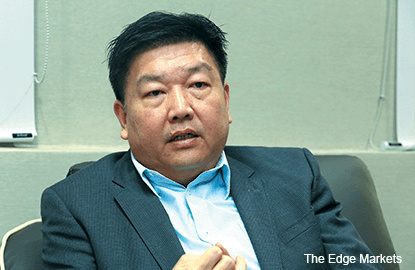
This article first appeared in The Edge Financial Daily, on 30 November, 2015.

KUALA LUMPUR: Telecommunication (telco) base transceiver station (BTS) builder OCK Group Bhd, expects to clinch two major contracts from local telco operators by the first half of financial year ending Dec 31, 2016 (1HFY16), continuing the growth momentum in the group’s top line.
In an interview with The Edge Financial Daily, group managing director Sam Ooi Chin Khoon revealed that the two major contracts are both construction jobs.
BTS, or more commonly known as telco towers, are used to transmit signals between operators’ call centres and mobile devices.
“In Malaysia there is plenty of work at the moment. We probably might announce one or two very big contracts that we will sign very soon. I think next year (FY16) we can enjoy similar growth like this year from our current businesses,” he said.
Last week, OCK announced that net profit for 3QFY15 jumped 62.24% to RM4.89 million from RM3.01 million a year ago, while revenue leaped 74.62% to RM83.7 million from RM47.93 million a year ago.
In the nine-month cumulative period (9MFY15), OCK’s net profit rose 44.55% to RM13.09 million from RM9.05 million last year, while revenue increased by 64.21% to RM210.13 million from RM127.97 million.
Along with the quarterly report, OCK also disclosed that a memorandum of understanding (MoU) had been entered into between the group and its Myanmar partner, King Royal Technologies Co Ltd, with Telenor Myanmar Ltd.
The MoU is for the building and leasing of tower infrastructure to Telenor. All parties aim to conclude the agreement in the next few weeks.
The contract being negotiated is for 12 years, and involves building 920 three-legged towers on a build-and-lease basis, with an expected completion date in 2016, with Telenor having two-month exclusivity to lease the facilities.
This means that after the two-month tenure, OCK could lease the infrastructure to more tenants. A typical three-legged tower would usually cost about US$80,000 (RM341,000) to construct.
Ooi said OCK would normally aim to achieve an internal rate of return (IRR) of 15% in build-and-lease projects.
“An IRR of 15% is meant for one tenant, if we manage to secure more tenants to lease the tower, then it (IRR) will be more than that,” he explained.
Suppose the group manages to seal a deal with Telenor, Ooi said OCK is confident of clinching more contracts in Myanmar.
“There is no agreement for the construction of a second batch of towers, but if we make a success out of the first project, I think we stand a good chance to win the second one from Telenor,” he said.
Other than Myanmar, the group also has presence in Cambodia and Indonesia.
For 9MFY15, 15.73% of OCK’s revenue came from outside Malaysia in the Asean region. This compared with 5.33% in the previous corresponding period.
Ooi said that OCK’s project in Cambodia involves dredging and laying works for 800km of fibre for Telecom Cambodia, the country’s state-owned telco company.
In Indonesia, he said OCK is only involved in maintaining BTS for the country’s telco tower companies.
“Currently, we are maintaining about 20,000 BTS in Indonesia. We prefer not to own BTS there as there are a lot of bigger telco tower companies in Indonesia, it is difficult for us to compete,” he said.
Locally, Ooi said competition among telco operators bodes well for OCK as the former will invest more in BTS construction.
“I think the construction business [of BTS] will still be strong for the next two years, due to the LTE (Long Term Evolution) deployment,” he said.
 Ooi reckoned that telco operators that have deployed LTE like Maxis Bhd, DiGi.Com Bhd, Axiata Group Bhd, U Mobile Sdn Bhd, and Packet One Networks (M) Sdn Bhd, will need another two years to complete the coverage in Malaysia.
Ooi reckoned that telco operators that have deployed LTE like Maxis Bhd, DiGi.Com Bhd, Axiata Group Bhd, U Mobile Sdn Bhd, and Packet One Networks (M) Sdn Bhd, will need another two years to complete the coverage in Malaysia.
“Telco tower is a very unique industry, when one operator spend, the rest will follow. For FY16, we already have 250 BTS in the pipeline, all under the build-and-lease model, and we will try to secure more,” he said.
Ooi also mentioned that OCK’s margins for the construction of BTS are quite attractive, especially those awarded by the Malaysian Communications and Multimedia Commission (MCMC).
“We provide a combination of maintenance, roll-out, equipment servicing, optimisation, drive-test, margin from some of these specifications are quite good, but if doing just the civil works, then the margin might be low,” he explained.
Ooi revealed that the gross margin for MCMC projects could go up to 30%.
Apart from BTS construction, due to the LTE deployment, Ooi said local operators are working to replace microwaves in signal transmission technology with fibre optic cable.
“LTE involves bigger data traffic, so fibre cable can increase the speed and capacity of transmission compared with microwave. In Malaysia, we have nearly 25,000 BTS, operators are fiberising their signal transmission technology,” he said.
“Therefore, I think more fibre trenching works will be deployed moving forward, and OCK now is one of the biggest fibre contractor for operators in Malaysia,” Ooi added.
One of the fibre trenching works OCK secured in 1HFY15 was from Maxis, with an estimated value of RM25 million.
OCK (fundamental: 1.6; valuation: 0.8) closed 1.5 sen or 2.17% higher at 70.5 sen last Friday, giving it a market capitalisation of RM546.7 million.
The Edge Research’s fundamental score reflects a company’s profitability and balance sheet strength, calculated based on historical numbers. The valuation score determines if a stock is attractively valued or not, also based on historical numbers. A score of 3 suggests strong fundamentals and attractive valuations. Go to www.theedgemarkets.com for more details on a company’s financial dashboard.